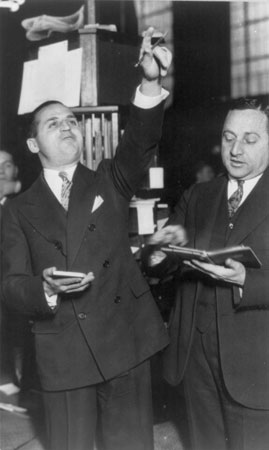

Despite the well-known images of the mid-twentieth century market, the NYSE has been in constant evolution since its beginnings as a “call market” with opportunities to trade stocks and bonds announced twice daily. In the 1870s the exchange implemented continuous trading and the “specialist” began to emerge. From his post on the floor the specialist made a market in a specific security, keeping a “limit order book” that gave him knowledge of how much stock investors were willing to buy or sell at a particular price. On the strength of this knowledge the specialist could buy and sell for his own account—but he was also supposed to perform a critical exchange function by maintaining a liquid market. “Floor brokers,” meanwhile, frequented these posts, buying and selling for customers who did not have access to the floor. Then there were the privileged few, “floor traders” who worked entirely in their own interest, and because they held seats, did not have to pay a commission.

Commissions undergirded everything that the NYSE did, and it was the chief topic of its founding document, the “Buttonwood Agreement,” promulgated in 1792 which provided that broker-dealers got the same commission per share whether they sold 5 shares or 500. This price fixing was curious for an institution that championed competitive capitalism, but it ensured ample compensation for all involved and enabled the NYSE to remain something of a gentlemen’s club. The Great Crash, the New Deal, and the Securities Exchange Act of 1934 brought all of this activity under federal regulation, and although the Securities and Exchange Commission required, rather than requested, specialists to maintain a “fair and orderly market,” it allowed them to retain their monopoly power and their fixed commission rates.
It was only when the NYSE sought, in the late 1930s, to strengthen its position that the SEC actually intervened in order to shape market structure. The 1930s were difficult for traders, and late in the decade president William McChesney Martin sought to keep as much business as possible on the exchange floor by enforcing a dormant regulation called the “multiple trading rule,” that forbade members from trading on other exchanges. The nation’s regional exchanges protested that the move would put them out of business. They had good reason to be worried. In the 1920s these regional auction exchanges flourished, with more than 50 regionals trading in NYSE stocks and local issues. By the time the NYSE sought to enforce the “multiple trading rule” in 1940, there were only 19 registered and 6 exempted regional exchanges.
Nevertheless, Martin went ahead. The SEC investigated, finding that “the multiple trading rule represents an attempt on the part of the largest and most powerful exchange to deal harshly with other exchanges and to make oppressive use of its powers to the detriment of smaller exchanges in other states and of the public they serve.” 2 In the fall of 1941, the Commission, led by Jerome Frank, ordered the NYSE to rescind the multiple trading rule.
In retrospect, this was an important move by the SEC. By shooting down the multiple trading rule, the SEC kept the NYSE from becoming a true monopoly in listed securities and ensured that competition would play a role in the evolution of equities trading. However, while members could now trade on other exchanges, the NYSE continued to ban any member from trading listed stocks on the OTC market.
The OTC market had grown up organically ever since brokers and a few private bankers (whose offices featured actual counters over which securities transactions were recorded) began selling large blocks of shares to the wealthy and smaller amounts to the less affluent. Rooted in the trades that had taken place outside the NYSE on the “curb” exchange, by the 1930s the OTC market was a largely invisible confederation of broker-dealers working in offices across the country. Every morning “market makers” consulted the “pink sheets” produced by the National Quotation Bureau which listed closing prices of unlisted securities, and through the day they matched buyers and sellers by telephone. Over the next few decades, the NYSE had the depth but the OTC market had the breadth: in 1970, the former dealt in 1,300 blue chip stocks, the latter dealt in about 10,000 more lightly traded issues. By allowing both the specialist market (NYSE and regionals) and the dealer market (OTC) to coexist, the Commission had ensured competition between two vastly different markets. And although the NYSE had prestige, the OTC market had potential.
By the 1950s, a lesser-known market had also sprung up as a direct result of NYSE Rule 394 which prohibited exchange members from trading listed stocks on the OTC market. This “third market” consisted of a handful of firms such as Weeden & Company which, because they were not members, could buy and sell NYSE-listed stocks off the exchange. By 1972, third market volume was about 8.5 percent of the NYSE, and Weeden was pushing hard to convince the SEC to ban NYSE Rule 394 (later 390) which had helped create his business. Competition between the specialist markets, the dealer market, and the third market enabled market structure to remain in flux during the mid-20th century, while the rise of institutional investors ensured that it did.
(2) SEC Memorandum of Law regarding Multiple Trading Rule (nd), 6.